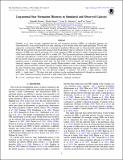| dc.contributor.author | Diemer, Benedikt | |
| dc.contributor.author | Sparre, Martin | |
| dc.contributor.author | Abramson, Louis E. | |
| dc.contributor.author | Torrey, Paul A. | |
| dc.date.accessioned | 2017-06-02T14:42:00Z | |
| dc.date.available | 2017-06-02T14:42:00Z | |
| dc.date.issued | 2017-04 | |
| dc.date.submitted | 2017-03 | |
| dc.identifier.issn | 1538-4357 | |
| dc.identifier.issn | 0004-637X | |
| dc.identifier.uri | http://hdl.handle.net/1721.1/109536 | |
| dc.description.abstract | Gladders et al. have recently suggested that the star formation histories (SFHs) of individual galaxies are characterized by a log-normal function in time, implying a slow decline rather than rapid quenching. We test their conjecture on theoretical SFHs from the cosmological simulation Illustris and on observationally inferred SFHs. While the log-normal form necessarily ignores short-lived features such as starbursts, it fits the overall shape of the majority of SFHs very well. In particular, 85% of the cumulative SFHs are fitted to within a maximum error of 5% of the total stellar mass formed, and 99% to within 10%. The log-normal performs systematically better than the commonly used delayed-τ model, and is superseded only by functions with more than three free parameters. Poor fits are mostly found in galaxies that were rapidly quenched after becoming satellites. We explore the log-normal parameter space of normalization, peak time, and full width at half maximum, and find that the simulated and observed samples occupy similar regions, though Illustris predicts wider, later-forming SFHs on average. The ensemble of log-normal fits correctly reproduces complex metrics such as the evolution of Illustris galaxies across the star formation main sequence, but overpredicts their quenching timescales. SFHs in Illustris are a diverse population not determined by any one physical property of galaxies, but follow a tight relation, where width ∞ (peak times)[superscript 3/2]. We show that such a relation can be explained qualitatively (though not quantitatively) by a close connection between the growth of dark matter halos and their galaxies. | en_US |
| dc.language.iso | en_US | |
| dc.publisher | IOP Publishing | en_US |
| dc.relation.isversionof | http://dx.doi.org/10.3847/1538-4357/aa68e5 | en_US |
| dc.rights | Article is made available in accordance with the publisher's policy and may be subject to US copyright law. Please refer to the publisher's site for terms of use. | en_US |
| dc.source | IOP Publishing | en_US |
| dc.title | Log-normal Star Formation Histories in Simulated and Observed Galaxies | en_US |
| dc.type | Article | en_US |
| dc.identifier.citation | Diemer, Benedikt et al. “Log-Normal Star Formation Histories in Simulated and Observed Galaxies.” The Astrophysical Journal 839.1 (2017): 26. © 2017 The American Astronomical Society | en_US |
| dc.contributor.department | MIT Kavli Institute for Astrophysics and Space Research | en_US |
| dc.contributor.mitauthor | Torrey, Paul A. | |
| dc.relation.journal | The Astrophysical Journal | en_US |
| dc.eprint.version | Final published version | en_US |
| dc.type.uri | http://purl.org/eprint/type/JournalArticle | en_US |
| eprint.status | http://purl.org/eprint/status/PeerReviewed | en_US |
| dspace.orderedauthors | Diemer, Benedikt; Sparre, Martin; Abramson, Louis E.; Torrey, Paul | en_US |
| dspace.embargo.terms | N | en_US |
| dc.identifier.orcid | https://orcid.org/0000-0002-5653-0786 | |
| mit.license | PUBLISHER_POLICY | en_US |
